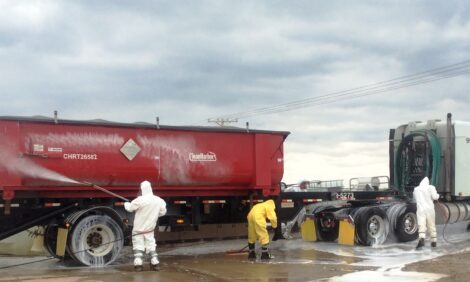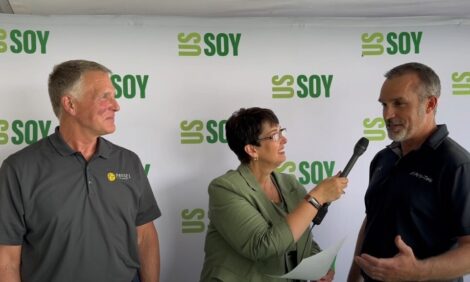



United Kingdom Pig Meat Market Update - May 2011
James Park, senior economic analyst with AHDB Meat Services Economic and Policy Analysis Group, explains the latest trends in the UK and EU.UK Prices
In week ended 23 April, the DAPP recorded the ninth consecutive week on week increase and, at 142p per kg, it was nearly five pence higher than at the start of the year. Despite the continued rise of the DAPP, prices remained considerably below the cost of production. Estimates for May place the cost of production at 164p per kg and if prices remain at current quotations, producers will continue to lose considerable amounts on every pig produced in the next month.

The UK producer price in the first three months of 2011 decreased, which was in contrast to the EU average price which increased considerably following the dioxin crisis in January. Higher throughputs at abattoirs may have restricted price movements in the UK and the higher EU price resulted in an erosion of the premium the UK obtained over the EU average.
Carcass weights reduced significantly during March to below 80kg, similar to year-earlier quotations. In week ended 23 April, carcass weights in the DAPP sample were marginally higher than 78kg, down from almost 81kg at the end of February.
The increase in finished pig prices exerted a positive influence on the weaner price with prices increasing by around 30 pence per head to average £44 in week ended 30 April. The April average was just below £43 per head, some £11 lower than the same month in 2010.
Sow market prices increased during March to average 95p per kg. The average sow price continued to increase at the beginning of April to 103p per kg, to exceed year earlier quotations.
Exchange Rates and EU Prices
The European average reference price increased four per cent in March and continued to increase to €155 per 100kg dw in week ended 23 April. The increase in the EU average eroded the premium that the UK obtained and the German reference price increased to exceed the UK average price in euro terms. The situation was enhanced by a weakening of sterling against the euro with a euro costing 87 pence in March compared with 86 pence in February.
Throughout April, the increase in the DAPP maintained a marginal premium over the EU average but the UK reference price in week ended 23 April was five euro lower per 100kg dw than the German price, in euro terms.

UK Slaughterings and Production
The latest DEFRA slaughtering figures covering March show that clean pig slaughterings were considerably above year-earlier levels as gains in productivity at the end of last year result in more pigs coming through the system. At 760,000 head, total clean pig slaughterings during March were eight per cent higher than they were a year ago.
Slaughterings in Scotland recorded the highest increase, being over 10 per cent higher than year-earlier levels, while slaughterings in England and Wales and Northern Ireland were approximately eight per cent higher.
Clean pig carcass weights declined slightly during March to track below year-earlier levels for the first time this year. Adult pig carcass weights were considerably lower in March being nine per cent lower than during March 2010. This is mainly the result of an increase in younger and lighter sows being killed as producers seek to mitigate losses.
Despite the generally lower carcass weights for the year to date, the significant rise in throughput have resulted in pig meat production increasing nine per cent year on year to over 203,000 tonnes.

In the first two months of 2011, imports of fresh and frozen pork into the UK totalled 56,000 tonnes, representing an increase of four per cent on year earlier figures. The majority of product came from Denmark, which recorded a 40 per cent increase in shipments. Imports from the Netherlands recorded an 11 per cent decline.
The volume of bacon imported into the UK during January and February declined 18 per cent to total 45,000 tonnes. This decline was driven by a 22 fall in shipments from Denmark, given the considerable increase in pork imports from Denmark, it is likely that there has been an increase in the production of bacon in the UK using Danish pork.
Imports of live pigs in the first two months of 2011 were up 12 per cent at 104,000 head, almost all of these pigs came from Ireland with a limited number coming from Denmark.
Exports of fresh and frozen pork from the UK were up over one per cent, totalling 21,000 tonnes. There was an increase in trade with non EU member states as exports to EU-27 countries declined four per cent. Germany remained the main destination for UK pork, however, volumes were down 28 per cent as the dioxin crisis led to over supply in Germany and lower demand for UK product.
Exports of bacon were up by half over the period to total 5,000 tonnes. The Irish, Danish and Netherlands markets all recorded considerably increased volumes being shipped to them. Offal exports were up 29 per cent as volumes being shipped to both Hong Kong and the Netherlands increased considerably.
Feed Prices
Grains
New crop grain markets were bullish towards the end of April as Northern Hemisphere weather conditions continued to be far from ideal. In the UK and Europe, dry conditions continued, fuelling November French futures to rise eight per cent in week ended 23 April to €225 per tonne (£198 per tonne) with UK November values also up eight per cent to £177 per tonne. Reports suggest that during March and April, the EU experienced only 25 per cent of the ‘normal’ rainfall levels. Added to this is that during the current dry weather, it is suggested that up to 5mm of moisture per day are being taken from soils. Wheat crops across Europe are reported to be increasing signs of drought-stress and the market reacted strongly as a result.
Russian spring plantings were around two weeks behind due to dry conditions and in the US, dry weather in the south continues to stress the winter wheat crop. Further north, too much rain was delaying US maize planting with only nine per cent planted against the 2006-10 average of 23 per cent. The slow maize plantings was causing concern that the crop will be in a less-than-ideal condition going into the July yield-forming period. Any detrimental news to the US maize crop will be reacted to strongly by global markets as US maize stocks at 17.14 million tonnes only represent a lowly 18 days of US demand; therefore the market does not have any supplies to fall back onto if there are any problems with US maize output this harvest.

Oilseeds
Concerns are developing over the 2011-12 EU rapeseed crop; the crop is forecast at only 20.1 million tonnes, down 0.5 million tonnes from this season. The German crop in particular was suffering from problems of winter kill and poor crop conditions. Initial crushing levels in the EU were seen very similar to 2010-11, at 22.3 million tonnes. In order to allow crushing to reach the levels seen this season, the EU may become reliant on imports from Ukraine; ending stocks are again seen down to 1.1 million tonnes, 0.2 million tonnes lower than 2010-11 and the lowest since 2007-08. The forecast lower availability of rapeseed is likely to cause a sustained dependence on soya for protein in animal feed. The harvest in South America was well underway with Brazilian progress nearing completion at 91 per cent complete and Argentina at 59 per cent in mid-April. Despite Argentine yields being 13 per cent lower at 12.87 tonnes per hectare this harvest a record Brazilian crop of 72 million tonnes is likely to keep demand satisfied over the spring and summer months.
 |
The US harvest in 2011 is now looking even more important to keep demand happy over the winter 2011-12 period; with production economics favouring maize plantings, the US area is expected lower meaning that stocks could come under pressure. The longer-term tight market outlook could be eased by the delays in maize plantings in the US currently. If plantings are delayed after 15 May, producers may switch to soybean plantings as they can be put into the ground later in the spring. Any increase in area planting may ease supply concerns for late 2011 if yields are good at harvest. In the latest HGCA feed ingredients price survey, FEMAS soyameal, ex-mill Liverpool, for May delivery is currently quoted at £309 per tonne with August delivery at £310 per tonne.
Despite the DAPP increasing during April, cost of production remained at historically high levels. It is estimated that for May GB producers costs of production will be 164p per kg of pig meat produced, equating to a loss of £18 per pig produced.
Consumption
Kantar Worldpanel data for fresh and frozen pork for the four weeks ended 20 March indicated that three per cent lower volume was purchased compared with a year earlier. This was largely driven by year-on-year reductions in the volumes of leg and loin roasting joints, which were down 18 and 48 per cent, respectively. These large drops were a result of strong promotions in the corresponding period a year earlier. Frying and grilling steak performed well in the four weeks ended 20 March with nearly 19 per cent greater volume purchased than the corresponding period a year earlier. Overall, more than 14,000 tonnes of fresh and frozen pork was purchased in the four weeks to 20 March.
In terms of value expenditure, almost two per cent less was spent on fresh and frozen pork in the four weeks to 20 March.
The 12 weeks to 20 March reported a marginal increase of less than one per cent in volumes purchased of fresh and frozen pork with growth restricted by a 33 per cent reduction in the volume of loin roasting joints purchased. Volumes of frying and grilling steaks purchased increased by 12 per cent and leg roasting joint purchases increased 12 per cent. During the 12 weeks, the amount of expenditure on fresh and frozen pork reduced by one per cent in comparison to a year earlier, indicating that the retail price for the most popular (frying/grilling steak) fresh and frozen pork declined.

May 2011






